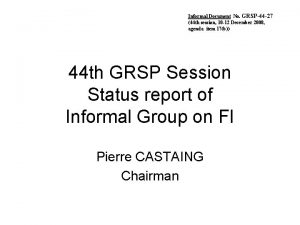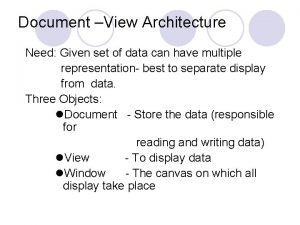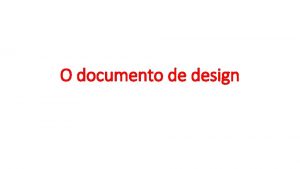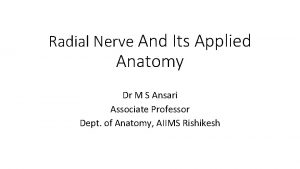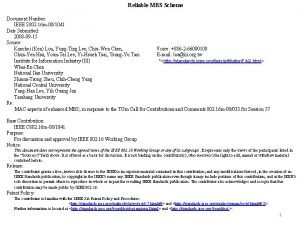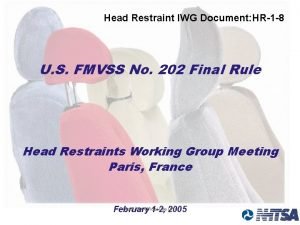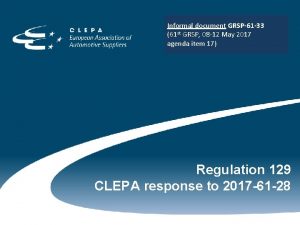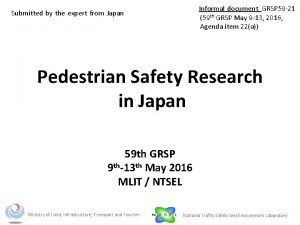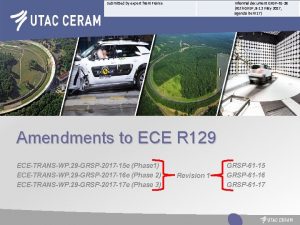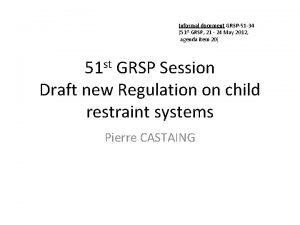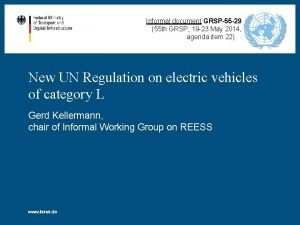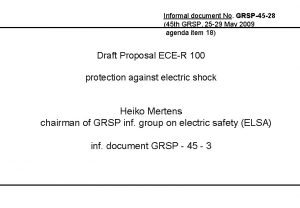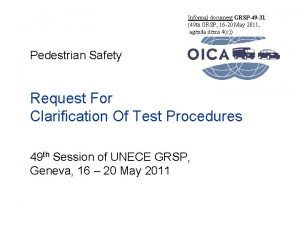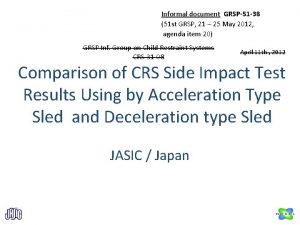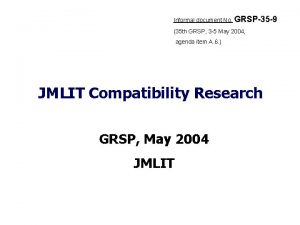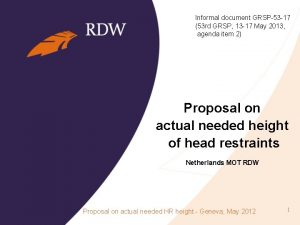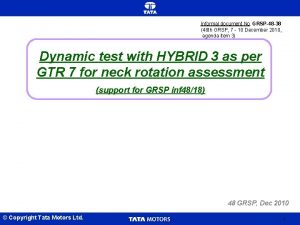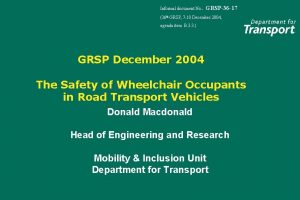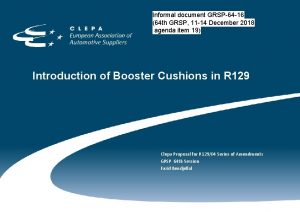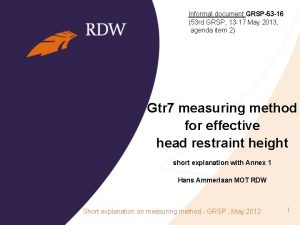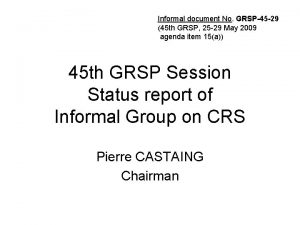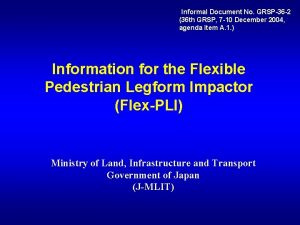Informal document GRSP61 24 61 st GRSP 8


















- Slides: 18

Informal document GRSP-61 -24 (61 st GRSP, 8 -12 May 2017, agenda items 14 and 26(a)) Submitted by the expert from Republic of Korea Introduction plan for implementing safety requirements of micro mobility 8 – 12 May 2017

Background Demand for micro mobility increased Small vehicle / Large vehicle due to changes in the social environment • Light and small vehicles accounted for 7. 57%, and large vehicles accounted for 6. 76% in 2014. • Deepening polarization of preferred cars for small and large vehicles. Eco-friendly vehicle • Strengthen CO 2 emission requirements. • Continuing government policies such as tax reduction on eco-friendly vehicles. Role as City Car • City car emerged as a means of short-distance transportation and complementary means of public transportation • Car sharing service was increased due to metropolitanization. Goals of CO 2 emission reduction for each manufacturer Advanced vehicle • GM plans to develop a micro mobility with autonomous driving function • Efforts of Europe, Japan, etc. to strengthen safety of micro mobility. -2 -

Research and safety requirement trend in other countries Europe • Micro mobility which is “car-like” was classified L 7 category. • Vehicle regulations of L 7 were strengthened to “Regulation (EU) No. 168/2013” from “Directive 2002/24/EC” in 2013. • In EU Regulation 168/2013, safety requirements on L 7 category were added and strengthened. • For example, “vehicle occupant protection” requirement was newly established and “rearward visibility” requirement was improved. • In Dec. 2016, the WP 29 addressed the need to improve the safety regulations of the L 7 category. • Definition of L 7 category Category L 7 Heavy Quadricycle Definition 4 wheels Mass ≤ 450 kg(transport of passengers), 600 kg(transport of goods) Seating positions ≤ 2 Vmax ≤ 90 km/h Pmax ≤ 15 k. W L 7 • Regulations of L 7 category Directive 2002/24/EC EU Regulation 168/2013 • 47 items for type approval. • In this directive, 25 items were mandatory. • L 6(Light quadricycle) category is the same • 36 items are mandatory. as L 2 category requirements. • Safety requirements were added and • L 7(Quadricycle) category is the same as • This regulation was amended in Jan, 2013, effective from Jan, 2017. strengthened. L 5 requirements. -3 -

Research and safety requirement trend in other countries Japan • Micro mobility was called as “Ultra small mobility”. • In several local governments, pilot projects are under progress. • Through the pilot projects, the usability and safety of ultra small mobility will be evaluated. Kei car • Ultra small mobility Max. Power ≥ 15 k. W Ultra Small Mobility • Included the Kei car sub-category. • Provisions to gradually meet the regulations of category M 1. • Carrying out the pilot projects to evaluate the usability and safety. • Apply the 40 km/h frontal impact requirement from 1994. • No safety provisions for Ultra small mobility. • Apply the 50 km/h frontal impact and side impact requirements from 1998. • Ultra small mobility definition • Kei-car accounted for 32% of the entire auto market in 2012, therefore the number of Kei car traffic accidents increased. ü Seating positions ≤ 2 • Need to strengthen the Kei-car safety requirements. ü Length, width, height < Kei car ü Max. Power ≤ 8 k. W ü Max. Velocity ≤ 90 km/h ü No roads dedicated exclusively for Ultra small mobility ü Compulsory system: Pedestrian alert system, Seat belt, Rear view mirror, Steering wheel Toyota i. Q -4 -

Research outline • Passive safety test Selecting test vehicle Selection of test vehicle that are available in Korea Researching regulations Review of overseas regulations that are applicable in Korea Seat, Safety-belt, Occupant protection, Frontal impact, etc. • General safety test Protective structure, Load platform, etc. • Active safety test Braking, Lamps, Steerability , etc. Testing as following regulations Tested according to the reviewed regulations Implementing regulations Establish micro mobility regulations in Korea • Performance test • Safety regulations Battery, EMC, Fuel consumption, etc. Safety regulations by sectors of general safety, passive safety, active safety and performance. -5 -

Selection of test vehicle Investigation of development and sales status • Development plan of domestic and foreign manufacturers ü 5 OEMs : No plan except for Renault-Samsung(Twizy). ü 6 medium-sized companies : 2 manufacturers undergoing development, 4 manufactures considering development plan. ü Foreign manufacturers(from KAIDA) : No sales plan in Korea. ü Foreign manufacturers’ development and sales plan (from Literature search) : 15 vehicles. • Selection of test vehicle ü Renault “Twizy”. ü Only Twizy is available in Korea. ü Domestic brand vehicle will not be available within our research period. Renault, Twizy

Regulations Review of EU regulations that are applicable in Korea Directive 2002/24/EC • 47 items for type approval. • In this Directive, 25 items were mandatory. • L 6(Light quadricycle) category is the same as L 2 category requirements. • L 7(Quadricycle) category is the same as L 5 requirements. EU Reg. 168/2013 • This regulation was amended in Jan, 2013, effective from Jan, 2017. • 36 items are mandatory. • Safety requirements were added and strengthened. Test item for establishing micro mobility safety regulation in Korea based on EU Reg. 168/2013 Sector General Safety Active Safety Passive Safety Performance Total Number of item Applying M 1 category regulations Added item for strengthening safety u 6 items Mass and dimension, Protective structure, Fuel storage, Load platform, Devices to prevent unauthorized use, Coupling device - u 2 items Braking, Steerability Speedometer u 4 items Rollover, Safety belt, Occupant Protection, Seats Frontal Impact, Pedestrian, Steering wheel impact, Door lock, Electrical safety u 9 items Audible warning device, Glazing, Lamp, Rearward visibility, Tire, EMC, Fuel consumption, Engine power, Wipers REESS safety, QRTV 21 items 8 items Application of EU Regulation 168/2013 -7 -

Tests Tested according to the reviewed EU regulation 168/2013 Sector General Safety Active Safety Passive Safety Test items Test results and remarks u 6 items • Mass and dimension, Protective structure, - In case of the dimension, considering the application of light passenger Fuel storage, vehicle regulation in KMVSS. Load platform, Devices to prevent - For mass, gross vehicle weight 550 kg including battery. unauthorized use, • Other items: Be able to apply of passenger vehicle(M 1) regulations. Coupling device u 3 items Braking, Steerability, Speedometer • Braking - Applying a form derived from two-wheeled motor vehicle braking system. - Need to apply of secondary braking system like a M 1 category braking system. - Need to develop exclusively Micro mobility ABS. • Steerability: Equivalent to M 1 category regulations. • Speedometer: Be able to apply passenger vehicle regulations. u 9 items Rollover, Safety belt, Occupant Protection, Seats, Frontal impact, Pedestrian, Steering wheel impact, Door lock, Electrical safety • Rollover: Apply roof crush requirement of KMVSS. • Safety belt: Need to strengthen the applying forces. • Occupant protection - Similar to the requirement for checking radius of curvature. - For other vehicles, no requirement of curvature radius in KMVSS. • Steering wheel impact: Considering this requirement in case of not applying frontal impact regulations. • Pedestrian - Expecting the high frequency of exposure to pedestrian. • Door lock, Frontal impact and Electrical safety are not assessed yet. -8 -

Tests Tested according to the reviewed EU regulation 168/2013 Sector Performance Test items u 9 items Audible warning device, Glazing, Lamp, Rearward visibility, Tire, EMC, Fuel consumption, Engine power, Wipers, REESS safety, QRTV Test results and remarks • Lamp - Mandatory: Head lamps, Direction indicators, Position lamps, Stop lamps, Reversing lamps, Rear registrations plate lamps. • Fuel consumption - Need a additional research for the test cycle. - FTP Mode(Passenger vehicle) or WMTC mode(Two-wheeled motor cycle) • Wiper - Need the mandatory installation requirements of wiper system when compulsory side door and window pane installation requirements are applied. • REESS safety - the tests carried out according to UN R. 136. • QRTV: Be able to apply passenger vehicle(M 1) regulations. -9 -

Examples of performed test Passive safety tests Pedestrian Active safety tests Rollover Occupant Protection Head form Impact Head form impact Before test Leg form Impact Door lock After test Seat belt Belt anchorage Braking Steerability Test equipment Test result Speedometer Performance tests Fuel consumption Lamp Rearview visibility Wiper Audible warning REESS EMC - 10 -

Issues related to crash worthiness Seat and Safety belt anchorage requirement Applied regulations • Based on EU R. 168/2013 and KMVSS 97 and 103. • The loaded force on the safety belt anchorage is stronger(about twice times) in KMVSS than EU Regulation. Tractive force in EU R: 675 da. N Tractive force in KMVSS: 1, 078 da. N Performed test • First test results subject to application of the EU R. are met the requirement. • In second test according to KMVSS, safety belt anchorages withstood. ① First Row Test results • Issue 1. Strengthened the loaded force. In full frontal crash test result, the loaded force value on safety belt was about 800~900 da. N. We need to strengthen the applied load on the safety belt anchorage. ① 675 da. N(EU R. ). ② Second Row According to test results, there is no problem that the test vehicle meets the strengthened requirements from now. Implementing regulations • Considering the implementation of strengthened regulations in Korea. ② 1, 078 da. N(KMVSS) - 11 -

Issues related to crash worthiness Door Lock system requirement Applied regulations • Based on EU R. 168/2013 and KMVSS 104(equivalent to GTR 1). • For evaluating the safety of door lock systems the test procedures of KMVSS is different from those of EU R. Performed test Test results • First test results met the requirements of EU R. . • In second test according to KMVSS, the door lock systems withstood the load and inertial test. • Issue 1. Strengthened the regulation. Door lock systems are very important in vehicle accidents because the door locks will prevent passengers from being ejected in the car accident. According to test results, there is no problem that the test vehicle meets the strengthened requirements from now. Test procedures of EU R. • Static load test in EU R. push force of 200 da. N, delivered by a flat-ended ram. Test procedures of KMVSS Implementing regulations Inertial test in vertical direction • Considering the implementation of strengthened regulations in Korea. • Load test and Inertial test in KMVSS - 12 -

Issues related to crash worthiness Pedestrian safety Applied regulations • Based on KMVSS 102 -2 (equivalent to GTR No. 9) Pedestrian Protection • Head Test Condition - Impactor (Impact angle) : Adult Headform(65°), : Child Headform(50°) - Impact Speed: 35 km/h - Injury Criteria: ≦ HIC 1000/1700 - Location: Worst / Typical area • Leg Test Condition - Impactor: Flex-PLI - Impact Speed: 40 km/h - Injury Criteria 1. ACL/PCL: ≦ 13 mm 2. MCL: ≦ 22 mm 3. T Bending Moment: ≦ 340 Nm - Location: CTR, Corner Performed test Test results • Head Test Result No Location HIC A 1 WAD 1900(CTR) 591. 60 ○ 2 WAD 1670(CTR) 340. 98 ○ 3 A-plr RH 1712. 78 X 4 Hood Corner 1990. 99 X 5 WAD 1000(CTR) 1307. 07 Δ 6 Wiper 1365. 93 Δ 7 A-plr LH 2007. 53 X Injury Result A Tibia Moment 284. 05 Nm ○ MCL/ACL/PCL 6. 95/4. 19/3. 67 ○ Tibia Moment 378. 15 N/m Δ MCL/ACL/PCL 9. 02/4. 86/2. 83 ○ • Leg Test Result Location Corner CTR • Issue 1 : Head form Test : Not adequate Test Area , or Extremely Narrow Test Area - Due to the short front - Not effective assessment (by the current regulation) • Issue 2 : identification of Bumper /Hood : Hard to distinguish bumper/hood - Due to the distinctive design (exposed tire, small front cover) - Not effective test area (if exemption zone is considered) Implementing regulations • Need to consider the new regulations of micro vehicles for pedestrian protection, if necessary. - 13 -

Issues related to crash worthiness Crash safety Applied regulations • Based on KMVSS 102, UN R. 94 and UN R. 95 (KMVSS 102 similar to UN R. 137) • KMVSS 102(Full frontal) - Test speed: 48 km/h - Rigid barrier impact test - Dummy: Hybrid III 50%ile - Injury measurement: Head, Neck, Chest, Leg • UN R. 94(Offset) - Test speed: 56 km/h - 40% Offset - Honeycomb block impact test - Dummy: Hybrid III 50%ile - Injury measurement: Head, Neck, Chest, Leg • UN R. 95(Side) - Test speed: 50 km/h - Movable barrier impact test - Dummy: Euro. SID II - Injury measurement: Head, Chest, Pelvis Performed test and results Full frontal Measurement Offset Side 860 893 2452 76. 6 - 0. 37 0. 67 - 3. 3 1. 56 1. 49 - Moment 57 48. 2 23. 7 - Deflection 50 / 42 19. 0 19. 4 6 / 19. 9 / 25. 2 VC 1. 0 0. 17 0. 09 0. 23 Acceleration 60 71. 2 Compression force 2. 0 - - 3. 49 Moment 200 - - 175. 4 Abdomen Abdominal peak force 2. 5 - - 2. 13 Pelvis Pubic symphysis force 6 - - 2. 89 Femur Compression force 9. 07 L: 3. 12 / R: 4. 83 L: 3. 25 / R: 3. 14 - Tibia Compression force 8. 0 L: 4. 5 / R: 6. 4 L: 2. 05 / R: 2. 66 - Sector Head Neck Chest T 12 Injury Requirement HIC 36 1000 Acceleration 80 Shear force 3. 1 Tension force -

Issues related to crash worthiness Full frontal impact 0 ms 20 ms 40 ms 60 ms 100 ms 150 ms 56 ms 86 ms 150 ms 200 ms Offset impact Side impact 80 ms: Head contact to the roof in vehicle 0 ms 50 ms 100 ms

Comparing KATRI crash test results with 2014 Euro. NCAP test results Frontal impact test results • Head and neck injuries of 2014 Euro. NCAP are similar to 2017 KATRI test. • In the case of chest injuries, the result of chest deflection in KATRI test improved significantly compared with those in 2014 Euro. NCAP. • Femur force value improved. 57% improvement in chest deflection 64% improvement in right femur force Side impact test results • In 2017 research, dummy head contacted the roof of vehicle and HIC value exceeded 1000. • Lower chest deflections improved significantly in 2017 KATRI research. • But, chest acceleration results was worse. • T 1 and T 12 injuries of spine in 2014 Euro. NCAP were similar to those in 2017 KATRI research. Remarks and issues • The comparison of crash tests showed that some areas of the test vehicle in 2017 KATRI research improved over 2014 Euro. NCAP. • Based on KATRI test results Korea is considering the strengthening of crashworthiness requirements. 98% improvement in in lower chest deflection 71% deterioration in lower chest Accel. Y - 16 -

Implementing regulations in Korea Phase-in application of micro mobility regulations Application Phase 1 u 43 items amendment in KMVSS • General safety: 20 items including mass and dimension, control and tell-tale signs, fuel storage, etc, • Active safety: 3 items including braking, steerability, speedometer. • Passive safety: 4 items including safety-belt, Door lock, etc. • Performance: 16 items including tire, glasses, fuel consumption, lamps, etc. Phase 2 u 4 items • Frontal impact • Side impact • Pedestrian safety • Braking(ABS) - 17 -

Thank you for your attention.
 Grsp rotary
Grsp rotary Document cookie set
Document cookie set Informal document
Informal document Ejemplos de culto informal
Ejemplos de culto informal Easa ftl regulations combined document
Easa ftl regulations combined document Document view architecture
Document view architecture High concept document
High concept document Document ppms vierge
Document ppms vierge Travel document systems inc
Travel document systems inc Document
Document Document c
Document c Synthese document
Synthese document Dom data structure
Dom data structure Executive summary business model canvas
Executive summary business model canvas Wartenberg syndrome
Wartenberg syndrome Scheme document number
Scheme document number Frida documentation
Frida documentation Electronic document exchange
Electronic document exchange Hr1 document
Hr1 document


